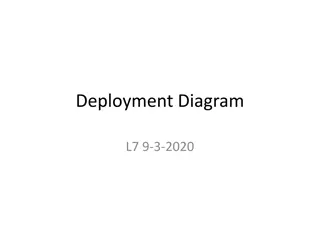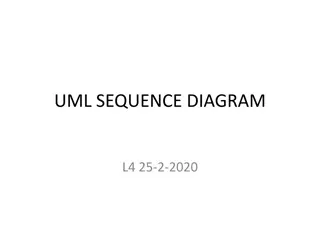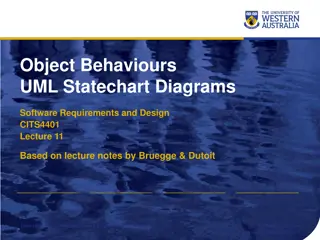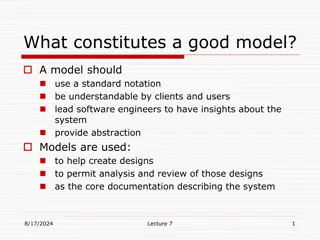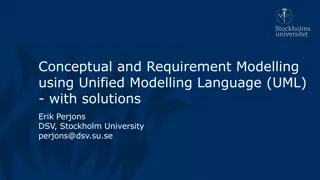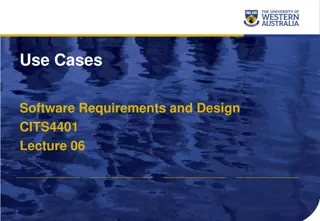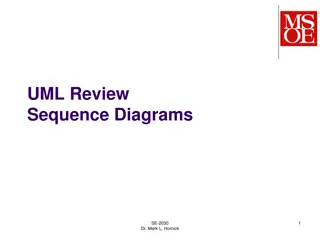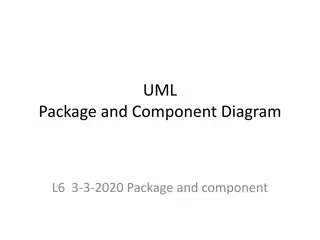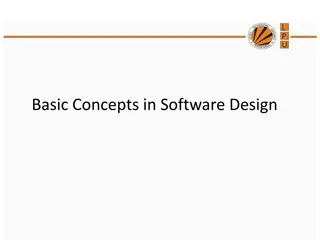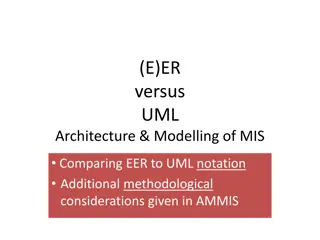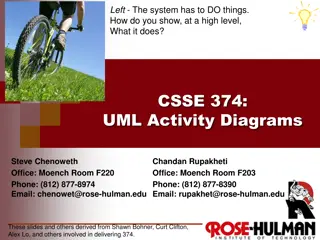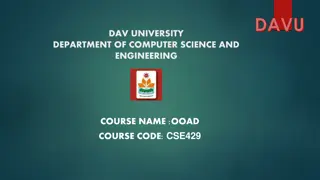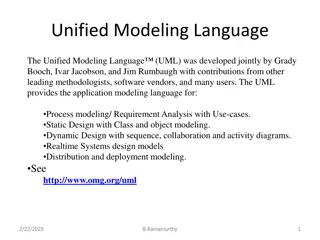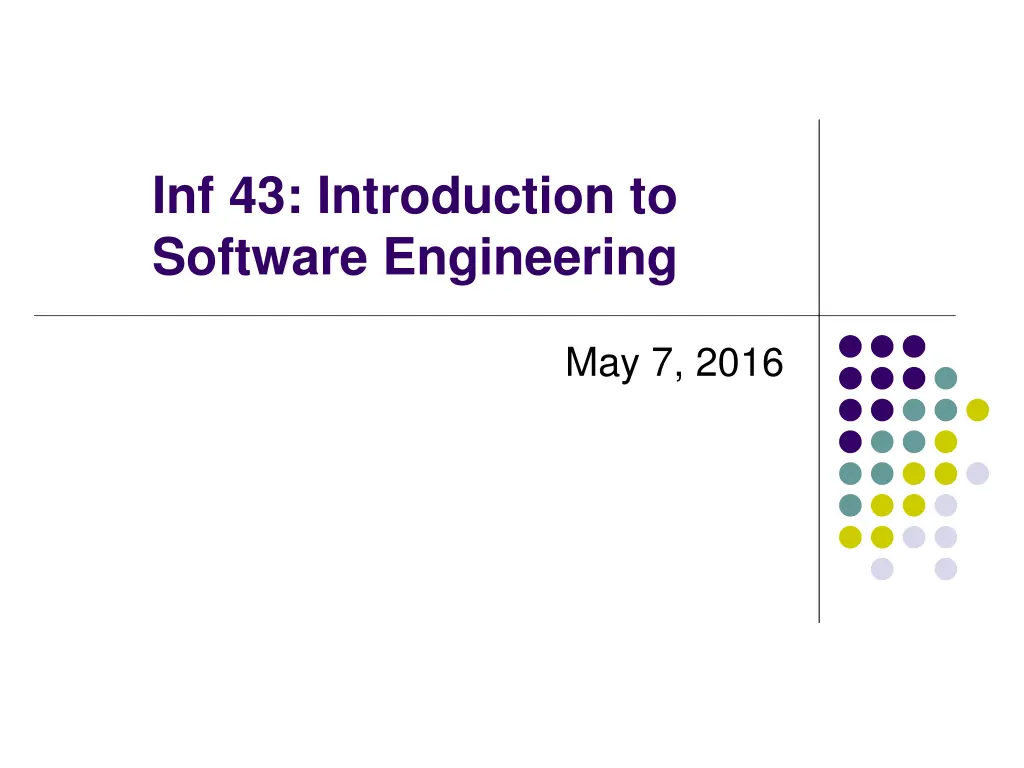
Understanding UML Modeling and Class Diagrams in Software Engineering
Learn about UML modeling and class diagrams, essential tools in software engineering for creating abstract models of systems. Explore the different components, relationships, and types of diagrams used for designing and visualizing software structures.
Download Presentation

Please find below an Image/Link to download the presentation.
The content on the website is provided AS IS for your information and personal use only. It may not be sold, licensed, or shared on other websites without obtaining consent from the author. If you encounter any issues during the download, it is possible that the publisher has removed the file from their server.
You are allowed to download the files provided on this website for personal or commercial use, subject to the condition that they are used lawfully. All files are the property of their respective owners.
The content on the website is provided AS IS for your information and personal use only. It may not be sold, licensed, or shared on other websites without obtaining consent from the author.
E N D
Presentation Transcript
Inf 43: Introduction to Software Engineering May 7, 2016
UML Modeling Diagramming is a language to create an abstract model of a system Types of Modeling Functional model Use cases diagram (behavior diagram) Object model Class diagrams (what we are going to talk about, structure diagram) Dynamic model Sequence diagrams, state machines etc. (interaction diagram)
Class Diagrams A class diagram is a diagram showing a collection of classes and interfaces, along with the collaborations and relationships among classes and interfaces A class (as used in object oriented programming and design) is a template for creating objects. Typically a class corresponds to a real world type that has properties/attributes and behaviors/operations.
Class Diagrams Main Components: Class Class name Attribute Operation Relationships (between classes) Generalization Association Aggregation
Class Diagrams: class Classes can have three parts Name Attributes (properties) Operations (behavior) Book Author : string Title : string Isbn : number Classes can show visibility and types. Archive () Borrow (client) Return()
Class Diagram: Relationships Association Aggregation Generalization
Class Diagrams Customer 1 Rental Invoice 1..* Rental Item {abstract} 1 0..1 Checkout Screen DVD Movie VHS Movie Video Game
Class Diagrams Cardinality Customer 1 Simple Aggregation Class Rental Invoice Abstract Class 1..* Rental Item {abstract} 1 0..1 Composition (Dependency) Simple Association Generalization Checkout Screen DVD Movie VHS Movie Video Game
Class Diagrams Association Name Class Name Customer Rental Item Rents +id:integer +id:integer 0..n 1 +name:string +released:date + accessAccount() Class Diagram Attributes Operations
Class Diagrams properties class name access modifiers CD CD CD CD title rating getTitle getRating match -title -rating +getTitle():String +getRating():String +match(String):boolean getTitle getRating match behaviour parameter lists return types
Class Diagram Relationships Generalization A relationship between a general thing and a more specific kind of that thing. It is a-kind-of relationship Shape Rectangle Square Polygon
Class Diagram Relationships Composition Combine simple objects into more complex objects It s a whole/part relationship. Diamond filled means the Point lifecycle depends upon Circle. When the Circle is destroyed, so are the Points it is composed of. Circle Point
Class Diagram Relationships Aggregation Combine simple objects into more complex objects It s a weak whole/part relationship. Diamond not filled means the Contact lifecycle does not depends upon ContactGroup. AddressBook ContactGroup 1 0..* 1 0..* 0..* Contact 0..*
Class Diagram Relationships Association Specifies that one object is connected with other It s not a whole/part relationship Weak relationship itsParent Frame Composite 1 Class Composite { Frame itsParent; Collection<Shapes>; } 0..* itsShapes Shapes
Class Diagram Relationships Dependency Very weak dependency; Not implemented with member variables at all; E.g., parameter variable, local variable Shape DrawingContext Draw(DrawingContext c)
Basic Class Diagram Symbols and Notations Multiplicity (Cardinality) Place multiplicity notations near the ends of an association. These symbols indicate the number of instances of one class linked to one instance of the other class. For example, one company will have one or more employees, but each employee works for one company only.
Example (On the white board)
ATM: Requirements Has a card reader, a customer console, an envelope acceptor, a cash dispenser, a receipt printer, and an operator panel. The ATM will communicate with the bank's computer over an appropriate communication link. A customer will be required to insert an ATM card and enter a personal identification number (PIN) - both of which will be sent to the bank for validation as part of each transaction. The customer will then be able to perform one or more transactions. The ATM must be able to provide the following services/transactions to the customer: cash withdrawal with approval obtained from the bank. Deposit with approval. transfer of money between any two accounts linked to the card. balance inquiry of any account linked to the card. The ATM will provide the customer with a printed receipt for each successful transaction The ATM will have a key-operated switch that will allow an operator to start and stop the servicing of customers. The ATM will also maintain an internal log of transactions Entries will be made in the log ATM is started up and shut down for each message sent to the Bank (along with the response back, if one is expected), for the dispensing of cash, for the receiving of an envelope.


